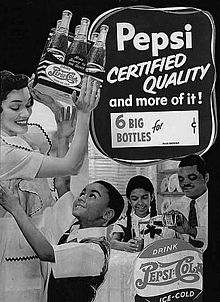„In 1886, in Atlanta, a pharmacist John Pemberton made a formula for Coca-Cola“…These are the words with which a recently new commercial for Coca Cola begins. The truth is that then, it had all begun. Indubitably, every single man, in every single corner of this planet was at least once in his life, introduced with this soft, sweet, black drink that with every single sip forces you to drink more and more. This non-alcoholic drink since the end of 19th century, when it was invented, became an instant hit and planetary popular. The advertising, besides a good taste, is definitely responsible for the worldwide success of it, which later developed in a powerful corporation.
The advertisements, as well as the target audience, changed and developed over time, adapting themselves to the needs of a market.
From its beginning, Coca Cola advertising largely influenced the American culture. In 1920s, the target audience were housewives and young couples who were smiling from the posters down on you, and recommended Coke as the ultimate refreshment.
In the famous winter campaign, in 1930s, the Santa Claus, as we know it, was made. Santa’s red-and-white image made an immediate association on this drink, and at the same time, Coca Cola became the synonym for happiness, and the wishes that came true. All you needed was to drink Coke, and the wishes would become reality.
In the 1960s and through 1970s and 1980s, Coca Cola used the pattern that many different corporations use nowdays in their advertising campaigns-the celebrities. Movie stars, sports heroes and popular singers were back then and are today idols to many people. They are successful, young and wealthy, a dream that come true in the eyes of the ordinary people. If they are drinking Coke, than this drink must be good, and if I drink it, I will be successful and happy, just as they are, that is the philosophy behind this kind of commercials.
Coca Cola slogans like “Open Happiness”, or “The Coke Side of Life”, convey a message of happiness and joy that Coke evokes in you while you drink it. However, in recent years, at least in our country, the focus of Coca Cola campaign is on family and the preservation of family values. The setting of this kind of commercials is at the table, while all family members are gathered over a meal. The family values and Coca Cola bottle which is at the centre of the table, and which gathers them around the table, are emphasized here.
Three years after Pemberton made Coca Cola, another variety of this drink, Pepsi Cola appeared on the market. The marketing of Pepsi and Co. was often called niche marketing due to advertisements that were addressed directly toward African Americans. The slogan from the 1940s campaign “Leaders in the Field” clearly sends the message to the African people who worked in the fields for rich landowners in America, that with Pepsi, they can feels like leaders, as well.
In later years, Pepsi launched a strong campaign against its major concurrent, Coca Cola. This campaign had, as its aim the predominance of Pepsi on the American, and world market, as well. The Pepsi challenge was introduced in 1975, which was a blind tasting of Pepsi Cola and its rival Coca Cola. During the tests, according to PepsiCo, the majority of people said that Pepsi tasted better of the two Colas.
Just like Coca Cola, Pepsi introduced many celebrities in its advertising campaigns, as well. Some of them are: Joanie Summers, The Jacksons, and in the recent years David Beckham, Pink, Beyonce, Justin Timberlake, etc…The famous one is a campaign with Britney Spears under the slogan “For those who think young”, which indicates that you will stay young and feel and look young, just as Britney, if you drink Pepsi.
Pepsi Stuff campaign, which lasted more than ten years, during which a lot of caps, T-shirts and jackets with Pepsi logo were sold, as well as Pepsiman, a mascot, contributed to popularization of this soft drink.
The third drink, which has similar taste, and can be compared to the previous too comes from the neighbouring country, precisely from Slovenia, and its name is Cockta. It was made in 1950s, and instatly became a smashing hit in the country, and abroad.
Its main advantage over both Coke and Pepsi was that it was made of all the matural ingredients and that was emphasised in its campaigns. The slogan for this campaign was: “No Caffeine, No Acid, No Kidding!”An implication here is that you can enjoy its full taste, without being afraid of any side effects.
Unlike PepsiCo and Coca Cola, Cockta emphasised the perspective of health in its advertising campaigns. One of the posters even depicted Chuck Norris holding a bottle of Cockta in his hand, under the slogan „Chuck Norris drinks it!“ Clearly, the picture was modified in photoshop, but it was still interesting, and a good joke.
In 2000s Cockta had its revival since it fell into oblivion due to the political situation and the wars in the 1990s that were waged in the Balkans. I tried it for the first time few years ago, and was not blown away by the taste, to be honest. On the other hand, my parents, especially my father simply love it, and refear to it as a drink of their youth, which was, by the way, Cockta’s slogan in 1980s.
There are various debates on the difference in taste and the preferece between Pepsi and Coke.I am probably not the right person to talk about that, since I don’t usually drink either of them, and can not taste any difference whatsoever. However, there are those who swear that the difference exists, and that Pepsi is sweeter than Coke. If you are interested in the right answer, taste both of them, and let me know.






Нема коментара:
Постави коментар